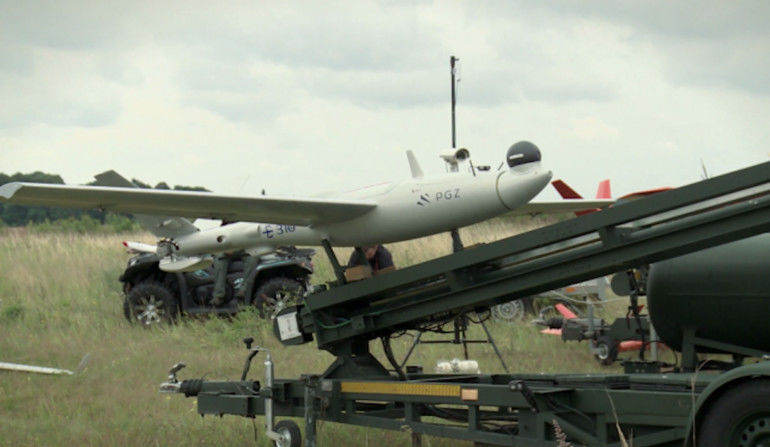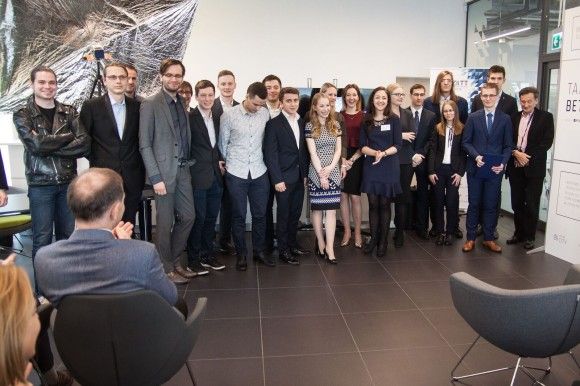Industry
PGZ Showcases Its UAV Offer
Polska Grupa Zbrojeniowa [Polish Armament Group] has organized a demonstration of the UAV systems, with the event taking place at the Drawsko Pomorskie military training area. Representatives of the Polish Ministry of Defence were also invited to participate. The presentation involved the following systems: tactical E-310 UAV, MJ-7 Szogun target drone and Atrax M quadcopter. All of the showcased systems have been controlled with the use of a ground control station.
The presentation of the UAV systems took place on 18th July this year, within the area of the Dynamic Test Centre of the Military Institute of Armament Technology, located in Drawsko Pomorskie. The event involved representatives of the companies which are gathered within the Polish Armament Group, along with the representatives of the Air Force Institute of Technology, Eurotech company, as well as representatives of the Polish Ministry of Defence, General Staff and of the Mirosławiec 12th UAV Base. The Mirosławiec Airbase is going to become a training centre and the main base for the UAV systems utilized by the Polish Armed Forces.
Polska Grupa Zbrojeniowa (...) is in possession of excellent capabilities when it comes to the unmanned aircraft. (...) We have presented three products that we are able to deliver for the Polish Army and for the foreign partners as well. Negotiation process within that scope is underway. Unfortunately, I cannot disclose the details of the contract at the moment, since they are a protected trade secret, and until the moment when the contract is signed I cannot confirm anything besides the fact that the negotiation is in progress.
The UAV systems offered for the Polish Army by the Polska Grupa Zbrojeniowa S.A. group were showcased on the ground, as well as in the air. The main portion of the event involved a dynamic display of the E-310, MJ-7 Szogun and Atrax M systems, jointly controlled with the use of a ground-based remote control station fitted onto a medium-weight vehicle. President of the PGZ company, Maciej Lew-Mirski, stressed the fact that the new systems have been designed with the Polish Army, as well as with the export customers in mind.
MJ-7 Szogun target drone is being used within the process of training the operators of the anti-aircraft systems. The described UAV has been developed by the Military Institute of Armament Technology, in collaboration with the Eurotech Sp. z o.o company based in Mielec. It is a mid-wing monoplane with a V-tail, propelled by an internal combustion engine. Szogun has a flight endurance of one hour, with cruise speed defined as up to 250 kilometres per hour.
The aforementioned drone may carry up to 6 kilograms of payload which may be used to change the radar signature of the UAV, simulate a specific IR-signature or to imitate the behaviour of a specific electronic warfare suite. Thanks to the above, this system may be utilized to train the crews of the anti-aircraft artillery and surface to air missile systems, who are in the process of learning how to use the optical, infra-red and radar-based guidance suites. MJ-7 Szogun may take-off with the use of conventional landing gear. During the Drawsko demonstration, a variant using a pneumatic launcher has been presented, similar to the one applied in case of the E-310 airframes.
E-310 tactical UAV is yet another design which has been presented during the Drawsko event. This system is being offered by the PIT-Radwar and Eurotech companies within the framework of the “Orlik” UAV programme which has been announced by the Polish military. This type of UAV is being launched from a towed launcher. The towing vehicle acts as the ground control station at the same time. Thanks to the above, the system is highly mobile and autonomous. It may become operable within several minutes.

The E-310 UAV offers flight endurance of up to 15 hours, within a radius of 150 kilometres from the ground control station, at altitudes of up to 5 kilometres. The said UAV is capable of attaining speeds of 120 – 180 kilometres per hour. Its take-off weight is defined as 80-90 kilograms, 20 kilograms out of which may be taken by the payload including a variety of reconnaissance systems. E-310 has a wingspan of 5.4 meters and is 2.8 meters long. The standard variant features an optronic sensor including a laser target designator.
Atrax M multi-copter is the third UAV presented in the air. The system has been developed by the Air Force Institute of Technology, and it is manufactured in collaboration with PGZ. This UAV is capable of attaining flight endurance of 60 or 30 minutes (respectively for the reconnaissance and combat variants). During the Drawsko Range event, Atrax M UAV carried out a simulated attack against a military vehicle, with the use of smoke and flashbang grenades. This was possible thanks to the fact that Atrax M platform, with own weight of 4.9 kilograms, has a take-off weight defined as 7 kilograms. The above capacity made it possible to develop a VTOL UAV capable of carrying out strike sorties.
Attack-reconnaissance Atrax M UAV features combat pods which house up to 4 shaped charges or grenades. A wide variety of armament is being offered too. Total weight of the ordnance carried by the UAV may reach up to 2 kilograms. Shaped charges that are capable of penetrating up to 120 mm of steel armour are offered as the basic weaponry. This type of armament may be used to act against light armoured vehicles or radar stations. Atrax may also be armed with non-lethal ammunition, including smoke or flashbang grenades, or fluorescent paint grenades which may be used by the uniformed services to act against riots or to mark the aggressive persons within the scope of crowd management.
The demonstration was to showcase the abilities of the equipment offered by the PGZ S.A. company for the purpose of combat operations. The presented UAV systems are expected to undergo a test programme in the future, which is to be carried out and organized by the personnel of the Miroslawiec 12th UAV base, in order to facilitate potential customization of the UAVs, so that they are tailored to the requirements of the Polish Army which is the basic customer who could receive the equipment offered by Polska Grupa Zbrojeniowa.


